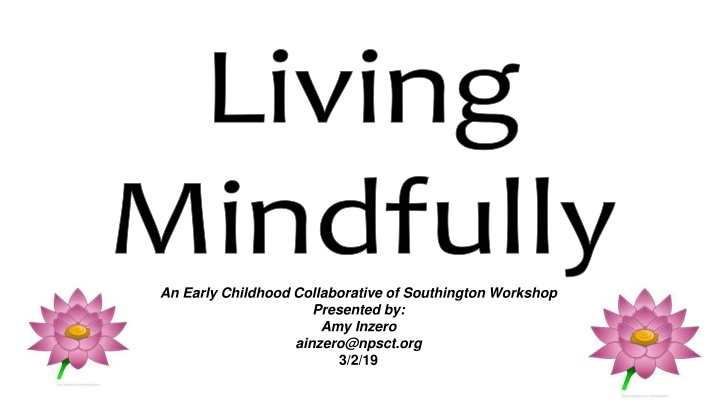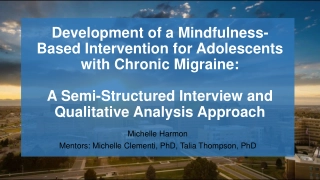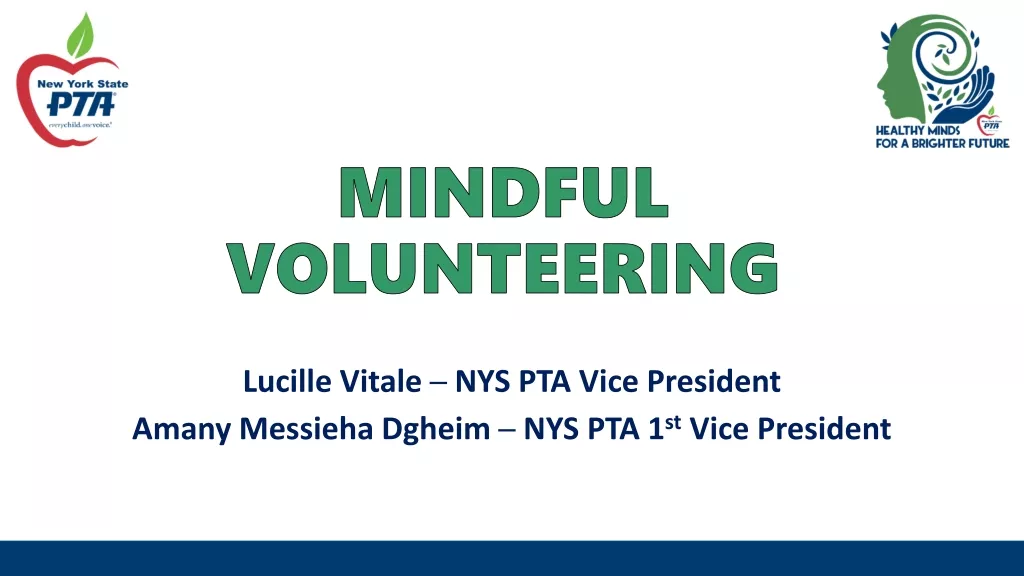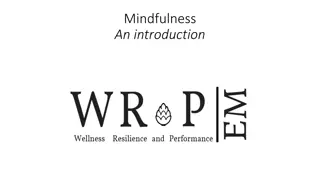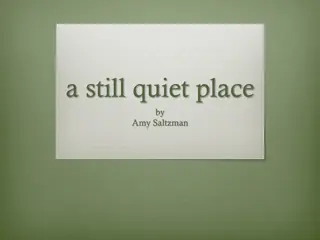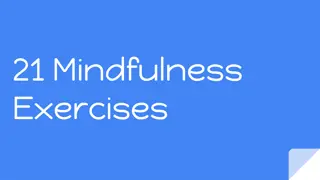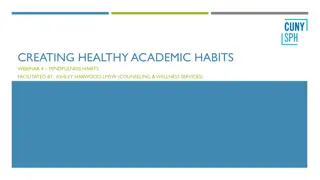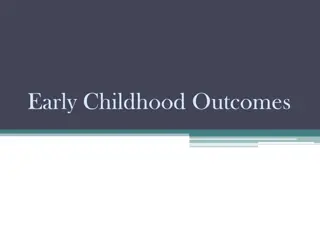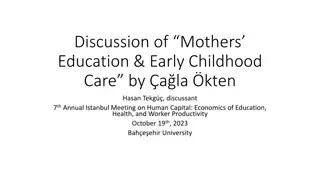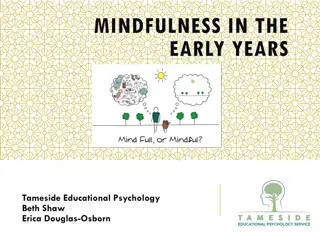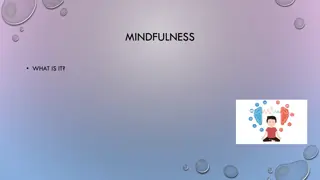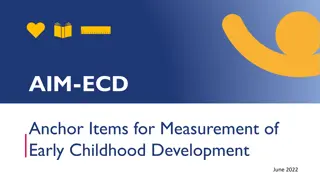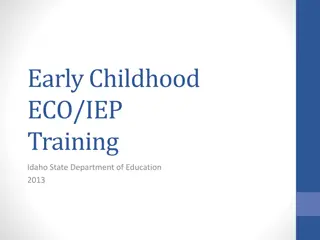Benefits of Mindfulness in Early Childhood Education Workshop
Explore the benefits of mindfulness in education through a workshop presented by Amy Inzero. Discover how mindfulness enhances focus, awareness, emotional balance, and stress management for both teachers and students. Learn practical strategies to integrate mindfulness into daily routines and foster a positive classroom environment.
Download Presentation

Please find below an Image/Link to download the presentation.
The content on the website is provided AS IS for your information and personal use only. It may not be sold, licensed, or shared on other websites without obtaining consent from the author.If you encounter any issues during the download, it is possible that the publisher has removed the file from their server.
You are allowed to download the files provided on this website for personal or commercial use, subject to the condition that they are used lawfully. All files are the property of their respective owners.
The content on the website is provided AS IS for your information and personal use only. It may not be sold, licensed, or shared on other websites without obtaining consent from the author.
E N D
Presentation Transcript
Living An Early Childhood Collaborative of Southington Workshop Presented by: Amy Inzero ainzero@npsct.org 3/2/19
Mindfulness is simply being aware of what is happening right now without wishing it were different; enjoying the pleasant without holding on when it changes (which it will); being with the unpleasant without fearing it will always be this way (which it won t). James Baraz
Todays Goal: Today s Goal: To identify the benefits of mindfulness and apply mindfulness to my life and to my students I will know I am successful when I can explain: I will know I am successful when I can explain: at least one benefit of living mindfully. at least one way I can apply mindfulness to my life. at least one way I can foster mindfulness with my students.
Research and Benefits: Research and Benefits: Mindfulness creates space, changing impulsive reactions to thoughtful responses. Mindfulness creates space, changing impulsive reactions to thoughtful responses. - -Mindful Schools, Emeryville, CA Mindful Schools, Emeryville, CA Yoga 4 Classrooms
Benefits (for teachers): Benefits (for teachers): Improves focus and awareness Increases responsiveness to students needs Promotes emotional balance Supports stress management and stress reduction Supports healthy relationships at work and home Enhances classroom climate Supports overall well being Mindful Teaching and Teaching Mindfulness
Benefits for Students Benefits for Students Supports readiness to learn. Promotes academic performance. Strengthens attention and concentration. Reduces anxiety before testing. Promotes self-reflection and self-calming. Improves classroom participation by supporting impulse control. Provides tools to reduce stress. Enhances social and emotional learning. Fosters pro-social behaviors and healthy relationships. Supports holistic well-being.
The Importance of Breath The Importance of Breath The practice is simply this: keep coming back to your breath during the day. Just take a moment. This will give your mind a steadiness and your breath a gracefulness.... There s so much to let go of, isn t there? Your nostalgia and your regrets. Your fantasies and your fears. What you think you want instead of what is happening right now. Breathe. ~Rodney Yee, Yoga: The Poetry of the Body
Mindful Breath Counting Mindful Breath Counting 1. Find a comfortable seated position 2. Close your eyes. Take a few deep breaths. Then let your breath come naturally. 3. Count 1 to yourself as you exhale. 4. The next time you exhale, count 2. 5. Continue this as you count to 5. 6. Then, begin a new cycle counting 1 on the exhalation. 7. Do not count higher than 5, and only count on the exhalation.
More Breathing... More Breathing... 3 Part Breath Buddy Breath Alternate Nostril Breathing Bumblebee Breath Breath of Joy https://www.doyouyoga.com/the-7-best-yoga-breathing- exercises-both-on-and-off-your-mat/
Visual Helpers... Visual Helpers... Hoberman s Sphere Glitter Jar https://heartmindkids.com/how-to-make-a-glitter-jar-for-mindfulness/
Consider This... Consider This... One good breath will allow a child to relax mentally and physically. One good breath will teach a child to pause before committing to her words and actions. One good breath will help a child release his anger and approach difficult situations with a clear mind. One good breath will help a child gather the courage to take a calculated risk , improve a child s focus, so she can perform better at school , on the ball field, at home. One good breath will remind a child to smile, to forgive, to play, to love, to live. If one good breath will help a child to achieve all of this, imagine what a lifetime of good breaths will do. Yoga 4 Classrooms
Resources related to mindfulness/stillness Resources related to mindfulness/stillness Child's Mind: Mindfulness Practices to Help Our Children Be More Focused, Calm, and Relaxed by Christopher Willard: Advice and instructions for a wide range of mindfulness exercises, along with creative approaches to making everyday experiences more mindful. Planting Seeds: Practicing Mindfulness with Children by Thich Nhat Hanh and the Plum Village Community: Instructions for dozens of mindfulness activities and noncompetitive games, which would be appropriate for classroom use or at home, summer camp, Sunday school, etc. A Still Quiet Place by Amy Saltzman: An eight-week mindfulness curriculum, with a balance of sitting practice, mindful movement, and compassionate discussion, along with comprehensive guidelines on how to teach mindfulness. Teach, Breathe, Learn: Mindfulness in and out of the Classroom by Meena Srinivasan: Mindfulness practices for busy teachers, as well as an eight-week mindfulness curriculum for students
Mindful Walking Mindful Walking Stand and relax your abdominal muscles and take several deep belly breaths. Begin walking. Walk so that one foot touches the ground on an inhale, and the other touches the ground on an exhale. Notice thoughts as they come and let them float by. Pay attention to the sensations of walking. Count your steps in time with your breathing. Counting Sounds & Rainbow Walking
Resources related to movement Resources related to movement Go Go Yoga for Kids: A Complete Guide to Yoga With Kids by Sara Weis: Advice for parents, classroom teachers, and professional yoga instructors on how to teach different ages of kids (3-6; 7-11; and tweens and teens) a variety of asanas (yoga poses), active movement, yoga games, and partner poses. Little Flower Yoga for Kids by Jennifer Cohen Harper: "Gentle yoga practices to help kids pay better attention and balance their emotions, while building physical strength and flexibility." https://yogibrarian.wordpress.com/2016/09/27/apples-yoga-storytime/ Yoga 4 Classrooms by Lisa Flynn Teaching Yoga for Life by Nannette Tummers Storytime Yoga by Sydney Solis
Listening Mindfully Listening Mindfully What makes you feel happy?
Compassion Meditation Compassion Meditation May you have happiness. May you be free from suffering. May you experience joy and ease. May you have happiness. May you be free from suffering. May you experience joy and ease. Self...Loved One...Neutral...Enemy...All Beings
Resources related to compassion Resources related to compassion Happiness Doesn t Come from Headstands by Tamara Levitt The Mindful Child: How to Help Your Kid Manage Stress and Become Happier, Kinder, and More Compassionate by Susan Kaiser Greenland: Instructions and activities for the most effective ways to teach and model mindfulness to kids. I Am Peace: A Book of Mindfulness by Susan Verde littlefloweryoga.com
Additional Ways to Incorporate Mindfulness Additional Ways to Incorporate Mindfulness Mindful Breathing, Observing, Listening, Walking, Eating Quieting Rituals Peace Corner Calming Music for Transitions and Other Times Honor Nature and Provide Outdoor Opportunities Use Story Time Effectively www.mindfulteachers.org
Resources Resources Books: Building Emotional Intelligence by Linda Lantieri Mindful Teaching and Teaching Mindfulness by Deborah Schoeberlein Mindfulness for Teachers by Patricia A. Jennings 10% Happier by Dan Harris Apps: Insight Timer Headspace Buddhify Calm Headspace Mindshift
Resources Resources Websites: www.jewelneverbroken.com www.copperbeechinstitute.org chopracentermeditation.com/ (Oprah and Deepak Meditation program) www.crec.org/mindfulness/ (CREC Mindfulness Conference)
Wherever you go, there you are Mindfulness practice means that Wherever you go, there you are Mindfulness practice means that we commit fully in each moment to be present; inviting ourselves to we commit fully in each moment to be present; inviting ourselves to interface with this moment in full awareness, with the intention to interface with this moment in full awareness, with the intention to embody as best we can an orientation of calmness, mindfulness, and embody as best we can an orientation of calmness, mindfulness, and equanimity right here and right now. equanimity right here and right now. Jon Kabat Jon Kabat- -Zinn. Zinn.
